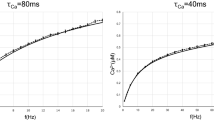Abstract
Spike-timing-dependent plasticity (STDP) induces competition among inputs, which is required for the construction of functional neuronal circuits, while maintaining the basic features of Hebbian plasticity. Here, we theoretically examine the competitive function of STDP incorporating a metaplastic activity-dependent feedback (ADFB) mechanism, wherein higher postsynaptic activity suppresses LTP, in cases where a neuron receives two groups of correlated inputs. We demonstrate that there are four distinct types of competitive properties depending on the relative input frequency between the different groups and the correlation time among the inputs within the same group. (1) Competition with a bi-stable synaptic weight distribution (for identical frequencies and brief correlation). (2) No competition (for identical frequencies and prolonged correlation). (3) Competition preferring strong input activity (for different frequencies and brief correlation).(4) Competition preferring weak input activity (for different frequencies and prolonged correlation). This may suggest that ADFB regulation can modulate the Hebbian competition properties associated with STDP to increase its ability to reflect input firing properties.
Similar content being viewed by others
References
Miller KD (1996) Synaptic economics: competition and cooperation in synaptic plasticity. Neuron 17:371–374
Polley DB, Chen-Bee CH, Frostig RD (1999) Two directions of plasticity in the sensory-deprived adult cortex. Neuron 24: 623–627
Feldman DE, Brecht M (2005) Map plasticity in somatosensory cortex. Science 310:810–815
Song S, Miller KD, Abbott LF (2000) Competitive Hebbian learning through spike-timing-dependent synaptic plasticity. Nat Neurosci 3:919–926
Kubota S, Rubin J, Kitajima T (2009) Modulation of LTP/LTD balance in STDP by an activity-dependent feedback mechanism. Neural Networks 22:527–535
Song S, Abbott LF (2001) Cortical development and remapping through spike-timing-dependent plasticity. Neuron 32:339–350
Hessler NA, Shrike AM, Mallnow R (1993) The probability of transmitter release at a mammalian central synapse. Nature 366:569–572
Bender VA, Bender KJ, Brasier DJ, et al (2006) Two coincidence detectors for spike-timing-dependent plasticity in somatosensory cortex. J Neurosci 26:4166–4177
Krupp JJ, Vissel B, Heinemann SF, et al (1996) Calcium-dependent inactivation of recombinant N-methyl-D-aspartate receptors is NR2 subunit-specific. Mol Pharmacol 50:1680–1688
Kubota S, Kitajima T (2010) Possible role of cooperative action of NMDA receptor and GABA function in developmental plasticity. J Comput Neurosci 28:347–359
Author information
Authors and Affiliations
Corresponding author
Additional information
This work was presented in part at the 15th International Symposium on Artificial Life and Robotics, Oita, Japan, February 4–6, 2010
About this article
Cite this article
Kubota, S., Rubin, J., Kitajima, T. et al. A variety of competitive properties arising from STDP incorporating metaplastic regulation. Artif Life Robotics 15, 185–188 (2010). https://doi.org/10.1007/s10015-010-0791-x
Received:
Accepted:
Published:
Issue Date:
DOI: https://doi.org/10.1007/s10015-010-0791-x




